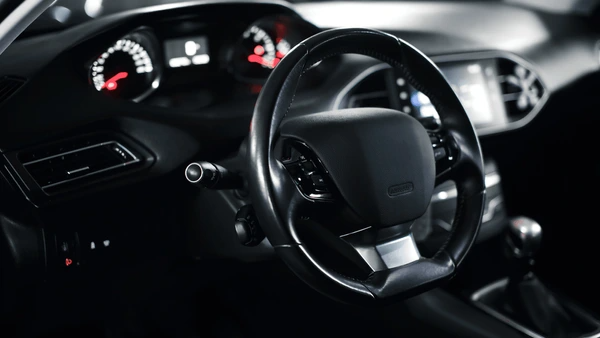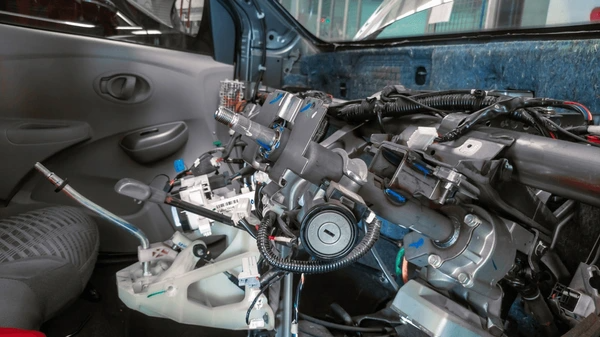
Introduction to Steering Column
A steering column is a critical component in a vehicle’s steering system, serving as the mechanical link between the steering wheel and the steering gear. Its primary function is to transmit rotational motion from the steering wheel to the steering gear, enabling directional control of the vehicle.

Components of Steering Column
- Steering shaft: Connects the steering wheel to the steering gear
- Column tube/shroud: Encloses the steering shaft, often telescopic for adjustability
- Mounting brackets: Secure the column to the vehicle body
- Locking mechanisms: Tilt and telescope locks to fix the column position
- Energy-absorbing devices: Straps, pins, or bellows that deform/break during impact
Types of Steering Columns
- Steer-by-wire steering columns: No direct mechanical coupling between the steering wheel and steering gear, using electronic signals for control
- Collapsible steering columns: Designed to collapse or break specific parts during a frontal impact to absorb energy and minimize driver injury
- Adjustable steering columns: Allow adjustment of steering wheel position (tilt and/or telescopic) for driver comfort
Common Issues and Maintenance of Steering Column

Adjustment and Alignment Issues
- Tilt and telescopic adjustment mechanisms can become worn or misaligned over time, leading to difficulty in adjusting the steering column position.
- Proper lubrication and periodic inspection of adjustment components like slides, clamps, and gear mechanisms are crucial for smooth operation.
Energy Absorption and Collapsibility
- Energy-absorbing or collapsible steering columns are designed to minimize driver injury during frontal collisions by controlled deformation or breakage of specific components.
- Factors like bracket slide displacement, clamping device strength, and predetermined force thresholds determine the energy absorption capacity.
- Detailed finite element modeling can accurately simulate the collapse behavior for design optimization .
Cover and Packaging
- Telescopic steering column covers need to accommodate increased axial travel for future autonomous driving modes, while maintaining aesthetics and crash safety.
- Innovative designs like telescopic casing elements with gear mechanisms, flexible materials, and overlapping tubes can provide extended adjustment range.
Durability and Failure Analysis
- Common failure modes include bearing wear, spline damage, and fatigue cracking due to cyclic loading and stress concentrations.
- Factors like material selection, surface treatments, lubrication, and load distribution influence the fatigue life and durability.
- Rigorous testing, finite element analysis, and strain measurement techniques are employed for failure analysis and design validation.
Manufacturing and Assembly
- Manufacturing processes like hot forging, machining, welding, and injection molding are involved in steering column production.
- Alternative joining methods like crimping can improve energy absorption performance and reduce process variability compared to injection molding.
Applications of Steering Column

Automotive Industry
The primary application of steering columns is in automobiles, where they serve as a crucial component of the steering system. Their key functions include:
- Connecting the steering wheel to the steering gear, enabling the transfer of rotational motion to steer the vehicle’s wheels
- Providing adjustability (tilt and telescopic) for improved ergonomics and driver comfort
- Incorporating safety features like collapsible designs to absorb impact energy during frontal collisions, minimizing driver injury
- Integrating sensors and electronics for advanced steering systems like steer-by-wire
Commercial Vehicles
Steering columns in commercial vehicles like trucks and buses have additional requirements:
- Robust construction to withstand heavy-duty usage and vibrations
- Multi-axis adjustability to accommodate a wider range of driver positions
- Pneumatic or electric actuators for effortless adjustment
Off-Road and Agricultural Machinery
Steering columns in off-road vehicles and agricultural equipment must be designed to handle:
- Rugged operating conditions and terrain
- Increased steering effort and torque loads
- Potential impacts and shocks during operation
Emerging Applications
With the advent of autonomous and connected vehicles, steering columns are evolving to incorporate:
- Steer-by-wire technology for enhanced control and safety
- Integration with advanced driver assistance systems (ADAS)
- Adaptability for shared mobility and autonomous driving modes
Application Cases
| Product/Project | Technical Outcomes | Application Scenarios |
|---|---|---|
| Tesla Autopilot | Using model quantisation techniques, inference speed increased by 4 times, and power consumption reduced by approximately 2 times. | Resource-constrained edge devices, such as in-vehicle systems requiring quick response. |
| Google BERT | Adopting optimised TensorFlow Lite, quantisation and knowledge distillation techniques, latency reduced by around 10 times, model size shrunk to 1/4 of the original size. | Real-time online services, such as search engines needing to process and respond to user queries swiftly and accurately. |
| NVIDIA Clara | Leveraging AI and advanced data analytics, it enables faster and more accurate diagnosis, treatment planning, and clinical decision support. | Healthcare facilities, assisting radiologists, pathologists, and other medical professionals in image analysis and clinical workflows. |
| Boston Dynamics Spot | Utilising advanced robotics, sensors, and autonomous navigation, it can traverse challenging terrains and perform tasks in hazardous environments. | Construction sites, industrial facilities, and disaster response scenarios where human access is limited or unsafe. |
| OpenAI GPT-3 | Employing large language models and few-shot learning, it can generate human-like text, code, and creative content with minimal prompts. | Content creation, code generation, virtual assistants, and any application requiring natural language processing and generation. |
Latest Technical Innovations in Steering Column
Adjustability and Ergonomics
- Improved guidance and adjustability mechanisms for steering columns to enhance efficiency and ease of use over time. This includes features like telescoping and tilting capabilities to adapt the steering wheel position to the driver’s preferences.
- Designs with increased telescopic operating range to maximize interior space utilization, especially for autonomous driving modes.
Collapsible and Energy-Absorbing Designs
- Collapsible steering columns that can absorb impact energy during collisions by controlled deformation or breakage of specific components. This helps minimize driver injury.
- Slip or collapse mechanisms that can describe the axial and lateral force behavior during impacts, improving safety.
Stowable and Removable Columns
- Steering columns that can be stowed or folded into the steering tube for improved portability and storage. This can involve telescopic collapsing or passing through the front fork.
- Removable steering columns for easier vehicle transport, with simpler and cheaper implementation than folding designs.
Steer-by-Wire Systems
- Steer-by-wire steering columns with no direct mechanical coupling between the steering wheel and road wheels, enabling advanced driver assistance features.
- Designs that enhance user comfort, convenience, and safety by leveraging steer-by-wire technology.
Structural Optimizations
- Optimized designs for improved torsional stiffness, durability, and reduced steering shaft looseness, achieved through techniques like simulated annealing algorithms.
- Lightweight and compact designs using materials like plastics and adhesives for components like upper axles and safety carriers.
Technical Challenges
| Improving Adjustability and Ergonomics | Developing mechanisms to enhance the telescoping and tilting range of steering columns to maximise interior space utilisation, especially for autonomous driving modes. |
| Collapsible and Energy-Absorbing Designs | Designing steering columns with controlled deformation or breakage of specific components to absorb impact energy during collisions, minimising driver injury. |
| Stowable and Removable Columns | Enabling steering columns to be stowed, folded or removed for improved portability and storage, particularly for vehicles with long steering columns. |
| Increasing Telescopic Operating Range | Extending the telescopic operating range of steering columns to enhance space utilisation and overall rigidity within the vehicle interior. |
| Integrating Autonomous Driving Capabilities | Incorporating features in steering column designs to accommodate autonomous driving modes and enhance user experience during autonomous operation. |
To get detailed scientific explanations of steering column, try Patsnap Eureka.

